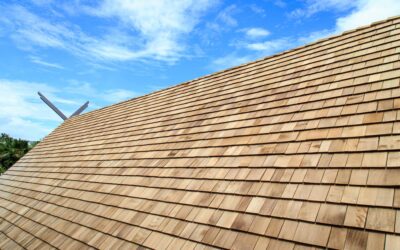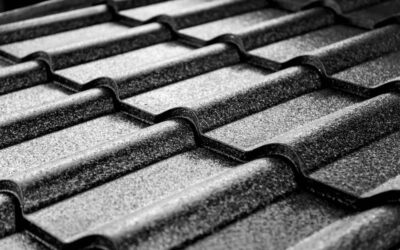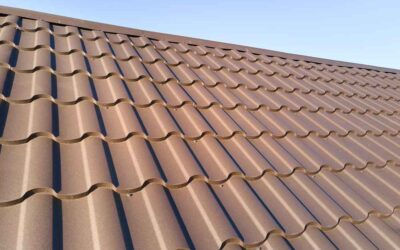Updated 8/21/2023
Quick Overview: Asphalt Shingles vs Metal Roofing
In the last 10 years or so, we have gotten an increasing number of phone calls from people with existing asphalt shingle roofs who are exploring the possibility of replacing their roof with a metal one. Both asphalt shingles and metal roofing are just the top surface of an integrated roofing system that protects the interior of a building from the elements. However, they are very different product lines, and so it is worth exploring the factors that might make one a better fit for someone’s needs. As our team has over 15 years experience in installing both asphalt and metal roofing systems, our only interest is in helping the customer make an educated decision about what’s best for their property.
Asphalt Shingles: The most common residential roofing material used in the United States, asphalt shingles are economical, durable, and easy to install. Most are lightweight, requiring no structural changes to the home when installed. They are Class A fire rated, and some varieties come in a Class 4 (impact/hail resistant) rating.
Metal Roofing: Metal roofing is reliable, long lasting, and lightweight. The installation of metal roofing requires a skilled crew, and the materials are also more expensive. However, the durability, and bold look (especially variety of colors, styles, and textures) are typically the reason that people opt for metal roofing.

Cost Considerations: Asphalt Shingles vs Metal Roofing
Metal roofs are more expensive. “How much more” is a more difficult to answer, because the cost variables are different for each roof type. In most residential applications, a ballpark range of final installed cost difference would put metal roofs at 1.5-2x the cost of asphalt shingles. However, there is much more to know about what goes into each (in fact, we have a whole educational Roofing Cost Series published just in that. We will try our best to summarize here.
Cost considerations: Things to Know:
-
- Any time you change from one roof type to another, each type of roof flashing has to be changed to the style designed for the new roof type. This added time and materials means costs to the building owner.
- Asphalt is faster to install on small and detailed surfaces. Both asphalt shingles and metal roofing are perfectly capable of functioning well on a detailed roof with many slopes (in the industry, this is called a “cut up” roof when there are many facets such as dormers, hips, etc). However, metal is more labor intensive to cut angles and install in small sections, which rapidly increases costs.
- Metal is faster to install on large, simple surfaces. While this is only true for large, uninterrupted roof slopes, this factor acts contrary to the trend of metal being more expensive, because faster installation means less labor cost. This is one reason why you more commonly see metal roofs on large simple buildings, like warehouses or barns. Note that this article is primarily focused on residential homes, but we also explore metal roofing viability for commercial applications as part of our Commercial Materials Series. See Is Metal Roofing Right for My Commercial Property?
- Metal material prices are more variable than other building materials. Construction material prices change all the time, and metal has some of the widest swings of all thanks to demand and economic variables.
We have only one highly-uncommon story about a time when a metal roof was cheaper than asphalt shingles on a standard residential home. In this case, the existing decking (wood surface that constitutes the base of an asphalt roofing system) was rotted out and would have needed replacement for a new asphalt shingle roof. Metal roofs do not have the same decking requirements, and can be properly installed (meeting code standards) over plank (sometimes called “space decking”) or purlins. In this particular scenario, OSB prices were really high at the time, and the cost savings from an avoided re-deck (installing new OSB over the whole roof) offset the difference between a metal roof. We share this rare story only to exhibit some of the factors at play in pricing out a roof and the various options available.
Performance Considerations: Asphalt Shingles vs Metal Roofing
Metal roofs are considered to have a longer usable lifespan than asphalt shingles. High-end asphalt products are able to compete, with many manufacturers offering 50-year product warranties, but in our opinion the reality is that in most cases, asphalt shingles are expected to get totaled out by an insurance claim (major storm, wind, hail event) before the end of the expected “undamaged” lifespan. Which means that a 50 year metal roof is much more likely to actually make it to year 50 without needing replacement than a 50-year asphalt shingle. The increased longevity in real use time between replacements is generally considered an environmental win, and metal roofs have a decreased need for routine inspection and maintenance, which is a win for remote or remotely-managed properties. Financially, even if an insurance claim is paying for the bulk of a replacement after a storm event, there is still the consideration of insurance deductible, and the work of coordinating a new roof, or building down time during replacements.
Which brings us to the second point – storm resistance. In particular, hail performance by asphalt and metal roofs is different, because the water-shedding ability of an asphalt shingle depends on an in-tact asphalt mat, which is susceptible to cracking and UV exposure resulting from hail impacts. If you’re interested, we have a detailed piece explaining What Are the Effects of Hail on a Composite Asphalt Shingle Roof? Generally, metal is more hail resistant, and meets Class 4 impact ratings (What is a Class 4 Rating & Who Makes That Determination?). Many people who are considering metal because of the longevity or durability in a hail market will end up also exploring the option for a premium asphalt shingle that meets Class 4 impact (also sometimes written “Class IV”) ratings. A Class 4 shingle will usually come out somewhere in between traditional asphalt shingles and metal roofing as far as price goes, and offer similar performance for hail. On the asphalt shingle side, we go into a lot more detail in what’s consistently one of our most popular articles, Should I Invest in a Class 4 Impact Resistant Shingle on My Home?
Snow sliding is a relevant performance factor for roofs in some markets. Metal roofs are notorious for snow sliding off as temperatures rise following a snow storm. This can either be considered a positive – as in the case of a mountain vacation property where extreme snow loads can damage a structure – or as a major safety hazard for falling snow hitting people, livestock, or damaging property. There are mitigation techniques, such as snow guards and heating coils. However, our main point is that snow slide is a relevant performance factor to consider when considering roof type between metal and asphalt if you live in a region where it snows.
Cosmetic/Aesthetic Considerations: Shingles vs Metal
Cosmetic Hail Dents on Metal Roofing
Here in the lower Midwest, the most important information we can share about an aesthetic decision comes down to a boring fact in the fine print of your property/homeowner’s insurance document. Metal roofing is less likely to suffer performance damage from hail. Broadly speaking, this is a good thing for the performance and longevity of your roof. However, it is important to know that most insurance policies have exemptions for “cosmetic marring,” meaning that if your roof becomes dimpled with hail and it is deemed to have no negative impact on the performance of your roof at shedding water/protecting the home, you just have to live with a dimpled roof or pay out of pocket to replace it. On shinier metal roofs, dents are more obvious as the blemishes catch the light. If your roofline is very visible from the street (steep roof, prominent angles, a major factor of the curb appeal to your house), then the possibility of living with a dented roof may be a deal breaker to some.
Various Styles of Asphalt and Metal Roofing
Because there are so many varieties of both asphalt shingles and of metal roofing products, it is challenging to even lump those categories into two neat columns when it comes to comparing aesthetic differences. For asphalt, the range goes from simple 3-tab to architectural shingles to designer products like diamond pattern or fish scale shingles. We have a whole article on just the variety of Asphalt Shingle Types. Metal roofs come in R-panel, standing seam, corrugated, and even metal shingles. Again, we have a more visual article showing and explaining the differences of Metal Roofing Types.
Color Variation
Certainly metal is unmatched when it comes to color. You just can’t get copper asphalt shingles. When the look someone wants for their property is bold, glossy black, or vibrant blue – metal simply cannot be replaced with any other option.
Regional Differences
Regional differences make the prevalence of metal roofs vary widely around the US. Solar reflectivity makes metal roofs more popular in arid regions. Green colored metal roofs are common on mountain properties, and sometimes even required by HOA communities in forested areas (usually vacation properties) to preserve the natural feel of the developed area. Metal roofs allow snow to slide off much more easily than asphalt roofs, which is either a good thing or a bad thing depending on your needs and the amount of snow in your region.
Conclusions
In the US, metal roofs have gained some popularity over the last 10-15 years, but still only make up a small minority of residential roofs. As more metal roofs pop up in neighborhoods across the US, they are an option that is on people’s radar when it comes time to decide what to put on their home during a roof replacement or new construction. Therefore, we receive a lot of questions from people as they explore roofing system options.
What building applications most commonly choose asphalt shingle roofing systems? Asphalt shingles are still the dominant material used in single-family residential homes across almost all regions of the United States. Cost is still the number one reason why people stick with more-common asphalt shingle systems. Multifamily and apartment units with sloped roofs have more variety in roofing material type, often based on the dimensions of the buildings and complexity of the roof slopes, but the majority still use asphalt shingles.
What buildings are often done in metal roofs? Long, simple buildings like barns, steep-slope (meaning not-flat roof) warehouses, agricultural buildings, and some multifamily or commercial buildings. These types of buildings tend to be more long-term investments for the owners, so the additional materials cost is worth the reduced maintenance and replacement timeline. Additionally, the simple structure of many of these buildings caters well toward metal installation – e.g. large surface areas, little complexity. Labor costs are higher when you have to do a lot of detailing on a “cut up” roof, as is more common on residential homes that have dormers, aesthetic level changes, hips and valleys (diagonal cuts required for the metal). In residential applications, we find that most of the people who select a metal roof ultimately do so out of a personal preference for the bold look of metal roofing.
Our team has over 15 years experience in installing both asphalt and metal roofing systems. That allows our number 1 priority to be educating people to make whatever decision is best for them and for their building application. Rhoden Roofing offers free inspections and consultations in the South/Central Kansas region and Wichita Metro Area.
This article is part of our ‘Residential/ Steep Slope Materials’ Series. Learn more about:
- Asphalt Composite Shingles
- Metal Roofing
- Wood/ Cedar Roofing
- Other
- Roof Component Materials
- Traditional “Organic” Felt vs Synthetic Underlayment: Which is better?
- What Is the Difference Between Open and Closed Valley Installation?
- Continuous Venting Ridge vs Static/Box Vents: Which is better?
- What Are the Benefits to a High Profile Hip and Ridge Shingle?
- What Is a Class 4 Rating? Who Makes That Determination?



